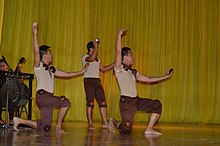| This article needs additional citations for verification. Please help improve this article by adding citations to reliable sources. Unsourced material may be challenged and removed. Find sources: "Maglalatik" – news · newspapers · books · scholar · JSTOR (December 2021) (Learn how and when to remove this message) |
 A performance of Maglalatik A performance of Maglalatik | |
| Genre | folk dance |
|---|---|
| Instrument(s) | coconut shells |
| Origin | Philippines |
The Maglalatik (also known as Manlalatik or Magbabao) is a folk dance from the Philippines performed by male dancers. Coconut shell halves are secured onto the dancers' hands and on vests upon which are hung four or six more coconut shell halves. The dancers are shirtless and wear only red pants. The dancers dance by hitting one coconut shell with the other; sometimes the ones on the hands, the ones on the body, or the shells worn by another performer, all in time to a fast drumbeat.
Maglalatik can be seen as a mock battle between the dancing boys. The dance is intended to impress the viewers with the great skill of the dancers. In some "Filipino Martial Arts" (FMA) circles, it is noted that the Maglalatik "consists of a trapping and boxing method hidden in a dance."
The name of the dance means "latik-maker", from latik, a coconut product that is used in Filipino cooking. The dance is also a war dance, depicting a fight between Moros and Christians over the latik.
References
- Namiki, Kanami (October 2, 2017). Ramon Obusan, Philippine Folkdance and Me: From the Perspective of a Japanese Dancer. Anvil Publishing, Inc. ISBN 978-971-27-3051-1. Retrieved December 6, 2021.
- Castro, Christi-Anne (May 5, 2011). Musical Renderings of the Philippine Nation. Oxford University Press. ISBN 978-0-19-987684-6. Retrieved December 6, 2021.
- SEATO Record. SEATO, Public Information Office. 1969. p. 33. Retrieved December 6, 2021.
- Duyan Ng Magiting: The Folk Culture of the Southern Tagalog Region. IMC. 1989. p. 78. ISBN 978-971-10-1241-0. Retrieved December 6, 2021.
See also
| Music of the Philippines | ||
|---|---|---|
| "Lupang Hinirang" (Philippine national anthem) | ||
| Traditional |  | |
| Post-1960s | ||
| Charts | ||
| Record companies | ||
| Musicians | ||
| Years | ||
| Other topics | ||
This Philippines-related article is a stub. You can help Misplaced Pages by expanding it. |